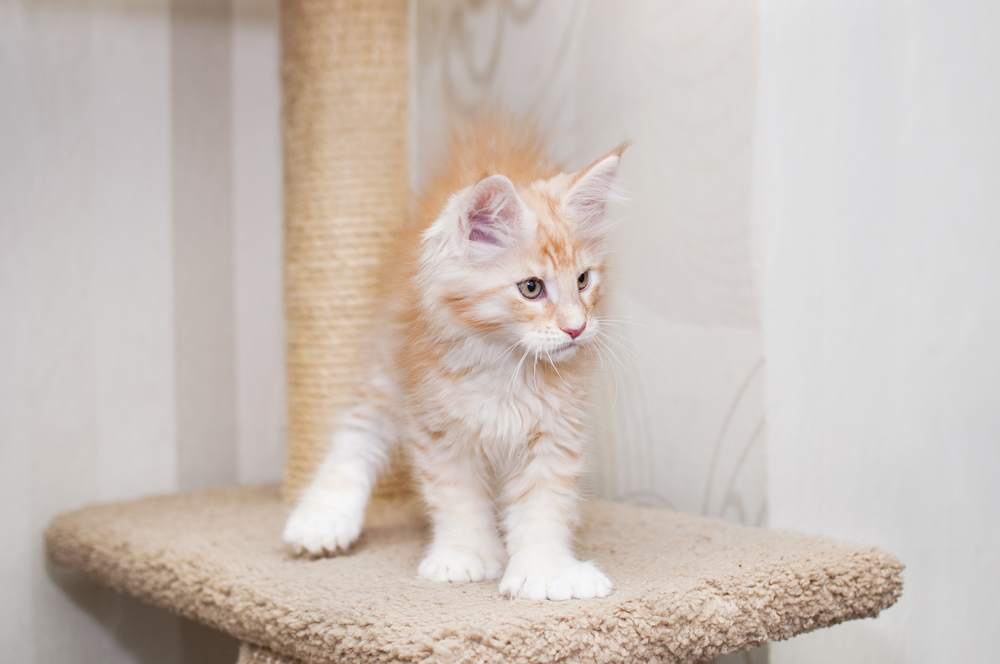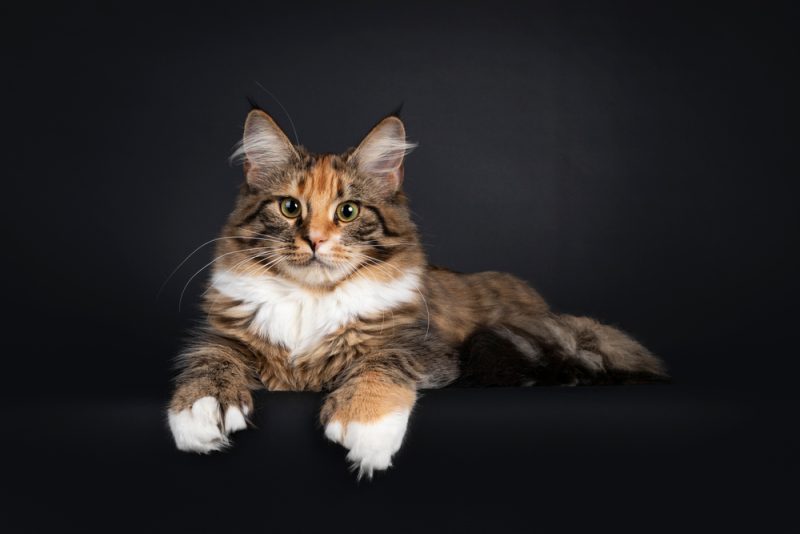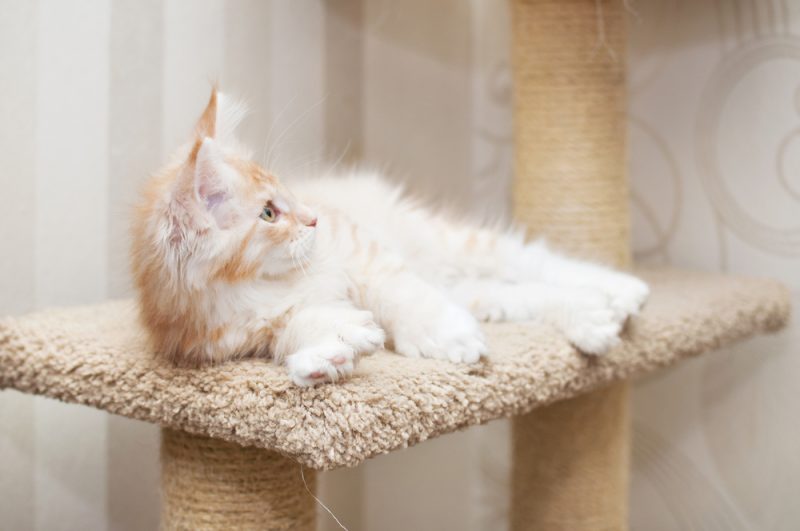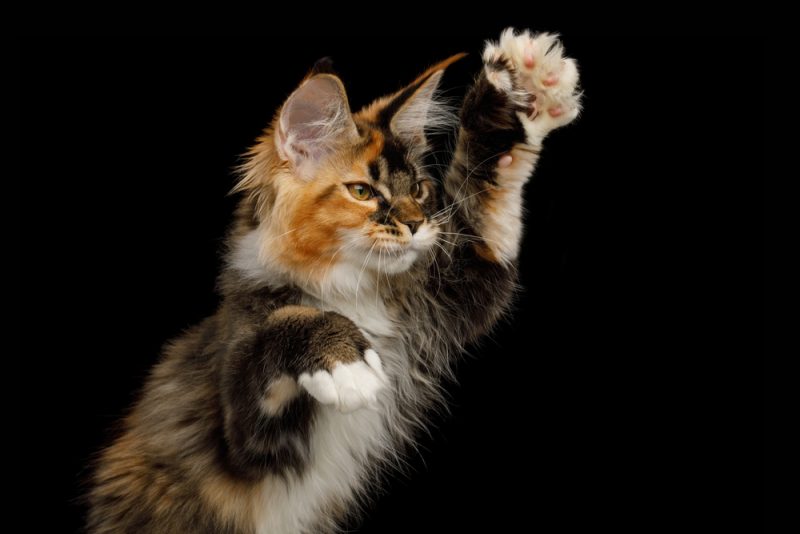- July 9, 2024
Polydactyl Maine Coon Cat Breed: Info, Pictures, Care & Facts

The Maine Coon already gets your attention without even looking at the cat’s feet and their polydactyly or extra toes. This trait can add extra digits to their paws. Polydactyl felines in general have an aura about them, no doubt, because of their association with author Ernest Hemingway. The Ernest Hemingway Home and Museum houses an estimated 60 cats, although they’re not Maine Coons. However, this breed specifically is known for carrying the polydactyl trait. Let’s learn more about these unique felines with extra digits.
Breed Overview
Colors:
All colors and patterns except pointed
Suitable for:
Active families looking for an outgoing cat with dog-like qualities
Temperament:
Playful, intelligent, hardy, friendly
The Maine Coon is an all-American cat breed, with their origin being right in the breed name. The state of Maine even has made them their state cat. It’s fitting, given the feline’s hardiness and muscular bodies. They can handle whatever the Maine climate sends them. It’s not just about the kitty’s large size. Their coat is weather-resistant, which gives them an edge during the harsh winters.
The Maine Coon is almost dog-like in their behavior. It’s one thing that attracts enthusiasts to the breed. Legends exist regarding the cat and their origins. The stories seem to match the large size of the feline. Most interestingly, their polydactyly is symbolic of the breed’s acceptance in cat registries and adds another interesting layer to the pet’s story.
Polydactyl Maine Coon Characteristics

Energy
+
A high-energy cat needs a lot of physical and mental stimulation to keep healthy and happy, while a low-energy cat needs minimal physical activity, but still needs mental stimulation. When choosing a cat, It’s important to ensure their energy levels match your lifestyle.
Trainability
+
Cats that are easy-to-train are more willing and skilled at quickly learning prompts and actions with minimal training. Harder-to-train cats are usually more stubborn or aloof and require a bit more patience and practice.
Health
+
Certain cat breeds are more prone to various genetic health problems, and some more than others. This doesn’t mean that every cat in those breeds will have these issues, but they do have an increased risk, so it’s important to understand and prepare for any additional needs they may require.
Lifespan
+
Due to their size or potential genetic health issues of a specific breed, some cats have shorter lifespans than others. Proper nutrition, exercise, mental stimulation, and hygiene also play an important role in your cat’s lifespan and quality of life.
Sociability
+
Some cat breeds are more social than others, both towards humans and other cats and animals. Cats that are more social have a tendency to rub up on strangers for scratches or jump on laps for cuddles, while cats that are less social shy away, hide, are more cautious, and even potentially aggressive. No matter the breed or gender, it’s important to socialize your cat and expose them to many different situations.

The Earliest Records of the Polydactyl Maine Coon in History
We know that the Maine Coon is one of the oldest breeds in North America. That probably explains its fascination among enthusiasts. The precise origins of polydactyly are unclear, but it begins with the cat. Some tales link the breed with the Vikings. Others credit Marie Antoinette with the feline’s origin. The truth is probably less romantic, involving seafarers traveling to the New World with their cats.
The Maine Coon’s story probably follows a similar path as early feline domestication in the Fertile Crescent roughly 12,000 years ago. Cats proved themselves useful as pest control on ships. Hardiness was another desirable trait under these challenging conditions. However, their known history goes back to the 19th century.
How the Polydactyl Maine Coon Gained Popularity
Pest control undoubtedly helped propel the feline’s popularity. Their hardiness and adaptability to the harsh climate were points in their favor. Their size and dog-like manners also endeared them to fans of this breed. This job nurtured the intelligence and temperament of the breed. Animals assigned to perform pest control have an independent streak, which is helpful for this job.
However, the polydactyl Maine Coon is also a friendly cat. This animal doesn’t hide when things are happening in the household. They want to know what’s going on in most cases. They are very people-oriented, which endeared them to cat lovers. It also helps that they get along with other household members, whether kids or dogs. They’re relatively tolerant and easygoing overall.

Formal Recognition of the Polydactyl Maine Coon
The Cat Fanciers’ Association (CFA) recognized the Maine Coon in 1976. The International Cat Association (TICA) followed in 1979. The polydactyl Maine Coon received its separate designation from the TICA in 2015. It’s worth noting, however, that the CFA considers this trait worth withholding the animal from the show ring.

Top 4 Unique Facts About the Polydactyl Maine Coon
1. Polydactyly Is a Dominant Trait
Only one parent has to contribute a copy or allele of this trait for it to present visually, making it a dominant trait.
2. No Preference for the Degree of Polydactyly Exists With the TICA Breed Standard
TICA seems to reward the polydactyly trait no matter how it appears in Maine Coon cats. The importance lies in its presence in the felines. On the other hand, the CFA doesn’t view it with merit.

3. The Polydactyl Maine Coon Is a Late Bloomer
Like big dogs, the Maine Coon is slow to mature, reaching their full size at 3 to 4 years. Keep this fact in mind when getting a kitten. The parents should be at least this age before breeding. A reputable seller will ensure this is the case. We suggest asking about the adults’ history to ensure you get a healthy pet.
4. The Polydactyl Maine Coon Isn’t the Only Animal With Extra Toes
Scientists have identified this trait in a few dog breeds, including the Great Pyrenees, Yorkshire Terrier, and Shetland Sheepdog.

Does the Polydactyl Maine Coon Make a Good Pet?
There’s a lot to be said for a hardy cat that is tolerant of many things. That describes the polydactyl Maine Coon, extra toes aside. They are hardy and relatively healthy. They are playful and agreeable with most pets and people, including kids. They are intelligent but need enrichment. That’s true of any animal to prevent boredom, though, as a bored pet is a destructive one.
The polydactyl Maine Coon loves people, so they thrive best with pet owners who interact with their cats often. These felines need this attention. They are good pets if they get the love and mental stimulation they need. You should groom your pet regularly, checking their ears and trimming their nails to keep them used to this handling.
The polydactyl Maine Coon loves attention, but they aren’t cuddlers. They like to observe and interact on their own terms. Nevertheless, these cats are sweethearts if you want a pet that stays involved with the household.
Health concerns with the Maine Coon are minimal, and the effects of being polydactyl are minimal. The cats adapt to their differences without any problems.

Conclusion
People often describe the polydactyl Maine Coon as a gentle giant because of the animal’s relatively large size compared to other cats. They have big mitts to match their large bodies. While the CFA doesn’t recognize this variation, the TICA embraces them with their own designation. Many find this trait endearing and unique. Nonetheless, this cat couldn’t be friendlier or more playful.
Featured Image Credit: Kutikova Ekaterina, Shutterstock
Tags
What do you think?
Related Articles

New Puppy Checklist: Gear You’ll Need for Your New Dog
Getting a new puppy is really exciting, but before you welcome them home, it’s important to prepare your space for them. Since puppies need a

How Big Do Mini Poodles Get? Vet Reviewed Average Weight & Growth Chart – Dogster
The information is current and up-to-date in accordance with the latest veterinarian research. Learn more » When you buy a Miniature Poodle, you might not

Can Police Dogs Smell Nicotine? Vet Verified Facts & Info – Dogster
The information is current and up-to-date in accordance with the latest veterinarian research. Learn more » While cigarette sales have been declining steadily for decades,

How Old Is 5 in Dog Years? Vet-Approved Guide to Each Size of Dog – Dogster
The information is current and up-to-date in accordance with the latest veterinarian research. Learn more » A common method for calculating a dog’s age is

